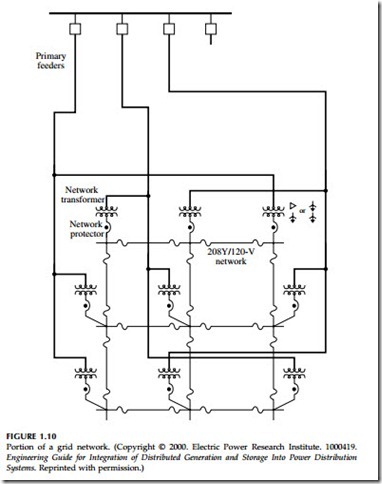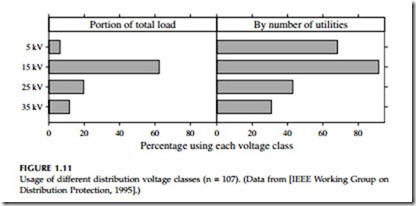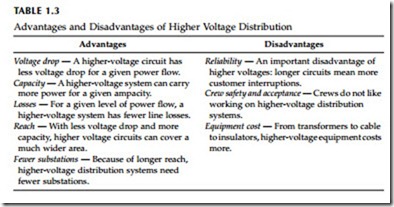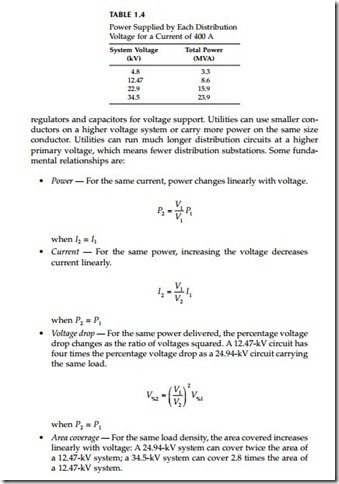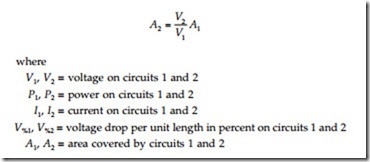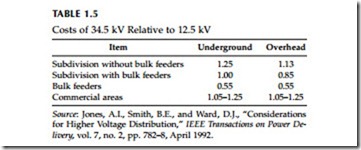Primary Voltage Levels
Most distribution voltages are between 4 and 35 kV. In this book, unless otherwise specified, voltages are given as line-to-line voltages; this follows normal industry practice, but it is sometimes a source of confusion. The four
major voltage classes are 5, 15, 25, and 35 kV. A voltage class is a term applied to a set of distribution voltages and the equipment common to them; it is not the actual system voltage. For example, a 15-kV insulator is suitable for application on any 15-kV class voltage, including 12.47 kV, 13.2 kV, and 13.8 kV. Cables, terminations, insulators, bushings, reclosers, and cutouts all have a voltage class rating. Only voltage-sensitive equipment like surge arresters, capacitors, and transformers have voltage ratings dependent on the actual system voltage.
Utilities most widely use the 15-kV voltages as shown by the survey results of North American utilities in Figure 1.11. The most common 15-kV voltage is 12.47 kV, which has a line-to-ground voltage of 7.2 kV.
The dividing line between distribution and subtransmission is often gray. Some lines act as both subtransmission and distribution circuits. A 34.5-kV circuit may feed a few 12.5-kV distribution substations, but it may also serve some load directly. Some utilities would refer to this as subtransmission, others as distribution.
The last half of the 20th century saw a move to higher voltage primary distribution systems. Higher-voltage distribution systems have advantages and disadvantages (see Table 1.3 for a summary). The great advantage of higher voltage systems is that they carry more power for a given current (Table 1.4 shows maximum power levels typically supplied by various dis- tribution voltages). Less current means lower voltage drop, fewer losses, and more power-carrying capability. Higher voltage systems need fewer voltage
The squaring effect on voltage drop is significant. It means that doubling the system voltage quadruples the load that can be supplied over the same distance (with equal percentage voltage drop); or, twice the load can be supplied over twice the distance; or, the same load can be supplied over four times the distance.
Resistive line losses are also lower on higher-voltage systems, especially in a voltage-limited circuit. Thermally limited systems have more equal losses, but even in this case higher voltage systems have fewer losses.
Line crews do not like higher voltage distribution systems as much. In addition to the widespread perception that they are not as safe, gloves are thicker, and procedures are generally more stringent. Some utilities will not glove 25- or 35-kV voltages and only use hotsticks.
The main disadvantage of higher-voltage systems is reduced reliability. Higher voltages mean longer lines and more exposure to lightning, wind, dig-ins, car crashes, and other fault causes. A 34.5-kV, 30-mi mainline is going to have many more interruptions than a 12.5-kV system with an 8-mi main- line. To maintain the same reliability as a lower-voltage distribution system, a higher-voltage primary must have more switches, more automation, more tree trimming, or other reliability improvements. Higher voltage systems also have more voltage sags and momentary interruptions. More exposure causes more momentary interruptions. Higher voltage systems have more voltage sags because faults further from the substation can pull down the station’s voltage (on a higher voltage system the line impedance is lower relative to the source impedance).
Cost comparison between circuits is difficult (see Table 1.5 for one utility’s cost comparison). Higher voltage equipment costs more — cables, insulators, transformers, arresters, cutouts, and so on. But higher voltage circuits can use smaller conductors. The main savings of higher-voltage distribution is fewer substations. Higher voltage systems also have lower annual costs from losses. As far as ongoing maintenance, higher voltage systems require less substation maintenance, but higher voltage systems should have more tree trimming and inspections to maintain reliability.
Conversion to a higher voltage is an option for providing additional capacity in an area. Conversion to higher voltages is most beneficial when substation
space is hard to find and load growth is high. If the existing subtransmission voltage is 34.5 kV, then using that voltage for distribution is attractive; additional capacity can be met by adding customers to existing 34.5-kV lines (a neutral may need to be added to the 34.5-kV subtransmission line).
Higher voltage systems are also more prone to ferroresonance. Radio interference is also more common at higher voltages.
Overall, the 15-kV class voltages provide a good balance between cost, reliability, safety, and reach. Although a 15-kV circuit does not naturally provide long reach, with voltage regulators and feeder capacitors it can be stretched to reach 20 mi or more. That said, higher voltages have advantages, especially for rural lines and for high-load areas, particularly where substa- tion space is expensive.
Many utilities have multiple voltages (as shown by the survey data in Figure 1.11). Even one circuit may have multiple voltages. For example, a utility may install a 12.47-kV circuit in an area presently served by 4.16 kV. Some of the circuit may be converted to 12.47 kV, but much of it can be left as is and coupled through 12.47/4.16-kV step-down transformer banks.
